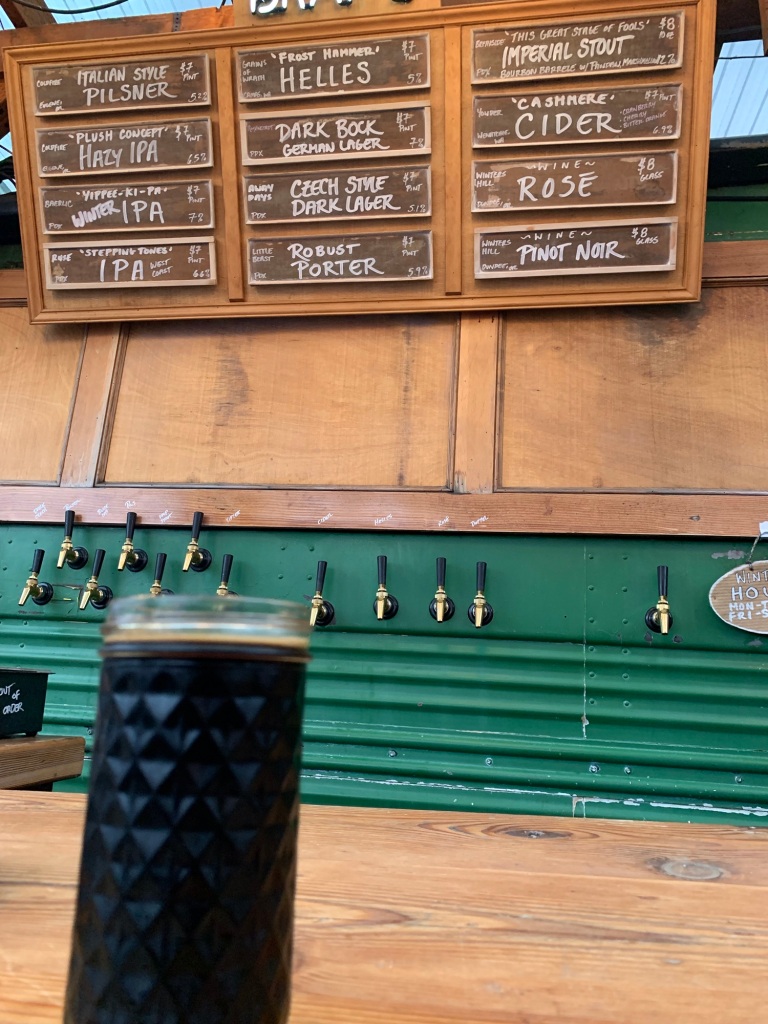Growing up in my wine enthusiast father’s house, I started learning about alcohol at 13. My sisters and I were passed small sips of whatever he and my mother were drinking, gently quizzed on what we tasted and smelled as far as our early-teen brains could describe ”flavor notes,” and then given an instructive lecture on that particular wine, where it came from, what caused those flavors, and the idea of terroir– that you could taste the unique chemistry of the soil and climate in the products of it’s earth.
I can tell you now that, despite my father’s instruction, I never really fell in love with wine. Unless it’s especially unusual, I will always enjoy wine as “interesting fun grape juice.” Unless it’s terrible, then I just don’t finish.
My dad was not speaking into a void though. What he said DID land and plant a seed, although it grew to be more inclined to beer and liquor, which I can say I then cultivated with the hearty fertilizers of sociology, history, anthropology, and being really damned curious when faced with the unfamiliar-but-promising.

With beer and liquor, the idea of terroir is still present if a little cloudier. The providence of the cereal grains involved in beer and whiskey or the fruit involved in brandies and eau-de-vies still counts, but the greater amount of processing involved compared to making wine or mead takes some craftsmanship out of natures hands and gives it over to the brewer.
I was siting in Pod 28 and chatting with Brian White– owner of the Captured Beer Bus, beer judge, cicerone, and an old buddy of mine- while writing this post. As I knocked back a Czech-Style Dark Lager (made in the city by Away Days, a British-styled brewery) and a Dark Bock (made by Rosenstadt, another Portland brewery that specializes in authentic German styles,) I realized I was in perfect company and context to raise the question of terroir in beer.
“Globalization is part of the reason for the muddling, to be sure” says Brian, indicating the Rosenstadt Dark Bock as a prime example. “These days, you can practically get everything you need to make an ‘authentic’ German beer shipped to you from Germany– the grains, the malts, the hops, the equipment, the yeast strain, all of it. The only things a hardcore professional might be able to taste between a German bock and what Rosenstadt makes here in Portland with all-German ingredients is possibly the mineral content of the water and the skill of the brewer.”
This was both fascinating and arguably a little depressing. Have globalization and scientific rigor really eliminated the flavor of the location that much from beer? Not so, according to Brian- rustic and rural styles leave more control in the hands of Nature.
“Wild fermented beers- sours, lambics, saisons and farmhouse styles- rely on the flavors of the wild yeasts in a given area. By cultivating specific yeasts, we can control for not just alcohol production but the flavors created by the esters in that yeast. When we let wild yeasts infect our beer, you’ll naturally get flavor profiles more common to areas where a certain strain of yeast is prevalent.”

My own early experiences wild-fermenting mead bore this out beautifully. By leaving fermentation in the hands of whatever wild yeasts and sugar-fermenting bacteria were present in raw honey, “the odds were good but the goods were odd” when the mead was finished. Not all yeast strains handle the same amount of alcohol before they stop fermenting, and they can leave different flavors behind ranging from the floral to the funky to the foul.
There’s a lot of fascinating science for the food nerd to dig into as far as where terroir comes from in practically anything, but for most of us- the average food-lover who just wants to know “what to serve with what,” it can be flattened out simply and beautifully. We can go from letting microbiology guide our menus to giving anthropology and sociology the wheel.
The truth is people will always make the food and drink that they like to have together. Generations of culture and develop do the matching- so let your food and drink come from the same culture, and the flavors will take care of themselves.
German beer styles- regardless of who makes them- give themselves naturally to the flavors of German food. The sour, the sweet, the fatty and savory- each area makes the beer that pairs perfectly with its food.
Mekong, a rum from Thailand, is a bit awkward mixed into a pina colada or a daquiri because the flavors and botanicals involved weren’t meant for those drinks. Making a simple punch or grog and having it with Thai food will demonstrate its place and potential. You can say the same for French or Spanish wines, Latin American cervezas or agua frescas, Greek ouzo, and Balkan rakia.
The hand of humanity may have taken some of the flavor of the earth from our food and beverages, but we can keep our egos from locking us into “what wine goes with what” but letting history and culture make that call. We’ll be less stressed and never disappointed so long as both food and drink are made with curiousity, humility, consciousness, and care.
Stay Classy,

There are some regions where isolation has maintained a large number of languages corresponding to separate cultures. I wonder if physical isolation can keep a strain of yeast that evolved randomly in a particular location from spreading and mixing with other more dominate strains. In the mountains areas of the Country of Georgia there are 20 dying languages that few people in the world speak. Maybe there’s still some yeast strain that lives on an isolated mountain. Perhaps the soil is exotic. There’s some island at the tip of Argentina with a unique language, culture, and maybe yeast. Hmm, I wonder how careful they’ll have to be with what they bring to a moon colony. I don’t know if they’ll bring German hops to the moon. Taste is an odd thing: orange juice mixed with apple juice tastes alcoholic even when it’s not fermented.
Nice post, Matt.
Sent from my iPhone
<
div dir=”ltr”>
<
blockquote type=”cite”>
Hey, Explore our wine selection and experience the difference of organic winemaking with Benchmark Wine. Order today!